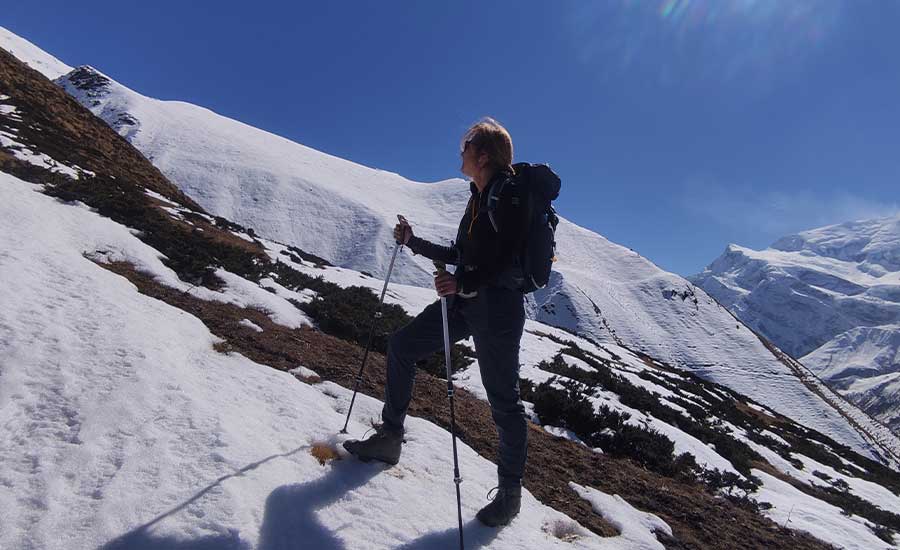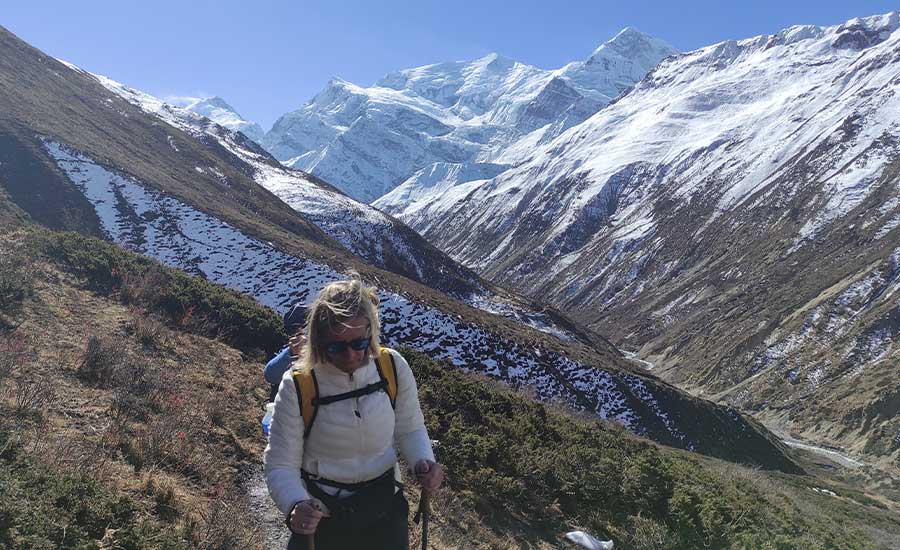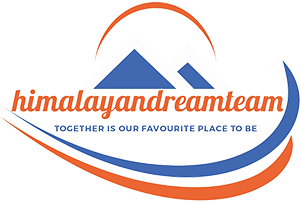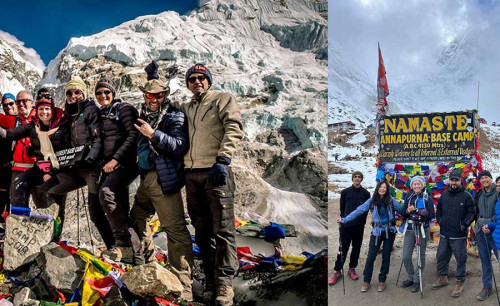Annapurna Circuit Trek Distance Guide (2025/2026)
Published On : 21st Nov, 2025 By Himalayan Dream Team

Annapurna Circuit Trek Distance – Complete Day-Wise Guide (2025/2026)
The Annapurna Circuit Trek is one of the most spectacular trekking routes on earth — a stunning loop around snow-capped Himalayan peaks, deep gorges, Buddhist villages, apple orchards, and one of the world’s highest passes: Thorong La (5,416 m).
But for new trekkers, one question always comes first:
👉 “How long is the Annapurna Circuit trek, and how many kilometers will I hike each day?”
In this detailed guide, Himalayan Dream Team breaks down the Annapurna Circuit trek distance, daily walking hours, elevation changes, and terrain difficulty, so you can plan your adventure confidently.
Overview: How Long Is the Annapurna Circuit Trek?
-
Total Distance: 160–230 km depending on the route
-
Standard Duration: 12–18 days
-
Highest Point: Thorong La Pass (5,416 m)
-
Average Walking Hours: 5–7 hours per day
-
Terrain: Forests, rivers, cliffside trails, high-altitude deserts, glacial valleys
With improved roads in lower regions, many trekkers now shorten the route by driving to Dharapani or Chame — reducing pure walking distance while still enjoying the classic high-altitude section.
Why Trek the Annapurna Circuit?
-
Walk through five climate zones
-
Stay in authentic Buddhist-Manangi villages
-
Enjoy epic views of Annapurna, Dhaulagiri, Manaslu, and Tilicho
-
Cross one of the highest trekking passes in the world
-
Experience Nepali hospitality, food, and culture along the trail
No other trek in Nepal packs this much diversity into one journey.
Annapurna Circuit Trek Distance Breakdown (Day-Wise)

Distance table rewritten and optimized for clarity
| Day | Route Segment | Distance (km) | Mode | Typical Hours |
|---|---|---|---|---|
| 1 | Arrival in Kathmandu | — | — | — |
| 2 | Kathmandu → Bhulbhule | 185 km | Drive | 7–8 hrs |
| 3 | Bhulbhule → Jagat | 14 km | Trek | 6–7 hrs |
| 4 | Jagat → Bagarchhap | 12 km | Trek | 6 hrs |
| 5 | Bagarchhap → Chame | 15 km | Trek | 6 hrs |
| 6 | Chame → Pisang | 13–17 km | Trek | 5–6 hrs |
| 7 | Pisang → Manang | 16 km (via Ghyaru/Nawal) | Trek | 5–6 hrs |
| 8 | Acclimatization in Manang | 3–10 km | Hike | Flexible |
| 9 | Manang → Yak Kharka | 10 km | Trek | 3–4 hrs |
| 10 | Yak Kharka → Thorong Phedi | 6 km | Trek | 3–4 hrs |
| 11 | Thorong Phedi → Thorong La → Muktinath | 16 km | Trek | 8–9 hrs |
| 12 | Muktinath → Jomsom | 15–18 km | Trek | 5–6 hrs |
| 13 | Jomsom → Pokhara | 160 km | Flight | 20 min |
| 14 | Pokhara → Kathmandu | 200 km | Drive/flight | 25 min–6 hrs |
| 15 | Departure | — | — | — |
Detailed Annapurna Circuit Distance Guide (Rewritten Fresh Content)
Below is a unique, alternative-style explanation of each day — optimized for SEO, user experience, and expert accuracy.
Day 1–2: Kathmandu → Bhulbhule (Drive – 185 km)
Your journey begins with a scenic drive following the Trishuli and Marshyangdi Rivers. Terraced fields, waterfalls, and traditional Gurung villages set the mood for the adventure ahead.
Although this day involves no trekking, it plays a key role in adjusting to altitude and preparing for the long route ahead.
Day 3: Trek from Bhulbhule → Jagat (14 km)
Walking Hours: 6–7
Elevation Gain: +450 m
Your trek begins gently along the Marshyangdi River. The trail introduces suspension bridges, steep stone staircases, and views of cascading waterfalls. Small settlements like Syange and Hani Gaon showcase rural life in Lamjung. The trail finally climbs to Jagat, a charming stone village and an official ACAP checkpoint.
Day 4: Jagat → Bagarchhap (12 km)
Walking Hours: 6
Walk through lush forests, river valleys, and dramatic cliffs. Tal village marks one of the most beautiful stops of the day — a wide riverside plateau. After crossing Karte and Dharapani, you reach Bagarchhap, decorated with prayer flags and Tibetan-style houses.
Day 5: Bagarchhap → Chame (15 km)
Walking Hours: 6
The trail passes through oak, rhododendron, and pine forests as the valley narrows into a deep gorge. Chame, the district headquarters of Manang, offers bakeries, hot springs, shops, and stunning views of Annapurna II.
Day 6: Chame → Pisang (13–17 km)
Walking Hours: 5–6
One of the most photogenic days. The trail crosses multiple suspension bridges and takes you beneath the towering rock wall of Paungda Danda, a massive curved cliff. Upper Pisang is the best place for sunrise views over Annapurna II and Pisang Peak.
Day 7: Pisang → Manang via Ghyaru/Nawal (16 km)
Walking Hours: 5–6
Choose the upper scenic route (recommended) for the biggest Himalayan panoramas. The climb to Ghyaru and Nawal is steep but incredibly rewarding — offering views of Annapurna II, III, IV, Gangapurna, and Tilicho Peak.
Descend to Manang, the cultural heart of the region.
Day 8: Acclimatization in Manang (3–10 km)
Explore Gangapurna Lake, Bhojo Gompa, or Milarepa’s Cave. This day is essential to prepare for the high-altitude climb toward Thorong La.
Day 9: Manang → Yak Kharka (10 km)
Walking Hours: 3–4
A steady ascent along grazing pastures leads toward the yak meadows of Yak Kharka. The air feels thinner, the landscapes more dramatic, and the peaks rise closer than ever.
Day 10: Yak Kharka → Thorong Phedi (6 km)
Walking Hours: 3–4
A short but demanding day through landslide zones and narrow trails. Thorong Phedi sits at the base of the great mountain pass, and the anticipation for tomorrow begins to rise.
Day 11: Thorong Phedi → Thorong La Pass → Muktinath (16 km)
Walking Hours: 8–9
Highlight: Highest point of the trek – 5,416 m
Start before sunrise and climb steadily toward Thorong La. The final push is demanding, but the summit rewards you with one of the most breathtaking Himalayan panoramas in Nepal.
After celebrating the achievement, descend to Muktinath, a famous pilgrimage site for Buddhists and Hindus.
Day 12: Muktinath → Jomsom (15–18 km)
A beautiful walk through Mustang’s desert landscapes, apple orchards, and windy river valleys. Enjoy views of Dhaulagiri and Nilgiri along the way.
Day 13: Fly Jomsom → Pokhara (20 minutes)
A scenic flight along the Kali Gandaki Gorge — one of the deepest gorges in the world.
Day 14: Return to Kathmandu (Drive or Fly)
A relaxing end to the trek, passing through green hills and river valleys.
Day 15: Departure Day
Himalayan Dream Team transfers you to the international airport with warm farewells.
How Difficult Is the Annapurna Circuit Trek?
-
Moderate to strenuous
-
The main challenge is altitude, not the daily distance
-
Proper pacing and acclimatization are essential
-
Thorong La Pass requires strong determination and early start
Total Annapurna Circuit Trek Distance – Classic vs. Modern Route Options

One of the most important details trekkers often overlook is that the Annapurna Circuit does not have a single fixed distance. The total kilometers you cover depend on where you start and end your trek — and whether you choose the traditional walking route or the modern shortened version.
Over the last decade, road development has changed the Annapurna region significantly. What used to be a strictly foot-only trail now includes jeep roads up to Chame on the eastern side and up to Muktinath/Jomsom on the western side. Because of this, trekkers can choose between:
1. The Classic Annapurna Circuit (Full Loop)
-
Total Distance: 170–230 km
-
Starting Point: Bhulbhule or Besisahar
-
Ending Point: Nayapul/Birethanti or Pokhara
-
Walking Days: 14–18 days
This is the original trail that circles the Annapurna Massif. It includes long, low-altitude stretches through rice fields, waterfalls, villages, and subtropical forests before entering the high-altitude desert of Manang. Although beautiful, many trekkers now skip the long, dusty road sections at the beginning and end.
2. The Modern Shortened Annapurna Circuit (Most Popular Today)
-
Total Distance: 110–160 km
-
Starting Point: Dharapani or Chame (reachable by jeep)
-
Ending Point: Jomsom or Muktinath (with flight/jeep to Pokhara)
-
Walking Days: 8–12 days
This option focuses on the best part of the circuit — the high-altitude section between Pisang, Manang, Yak Kharka, Thorong La Pass, and Muktinath. Trekkers skip road portions and concentrate on the cultural Himalayan regions that make this trek world-famous.
3. With Side Trips (Tilicho Lake / Ice Lake / Milarepa’s Cave)
If you add popular side trips, your total distance increases:
-
Tilicho Lake: +20–25 km
-
Ice Lake (Kicho Tal): +12 km
-
Manang Valley hikes: +3–10 km
These additions enrich the experience by adding spectacular viewpoints and helping your body acclimatize before crossing Thorong La Pass.
Why Knowing Route Variations Matters
Understanding route options helps trekkers:
-
Choose a trek suitable for their fitness level
-
Plan the right number of days
-
Estimate total walking distance more accurately
-
Customize their experience depending on available time
For example:
👉 Beginners or short-time travelers often choose the high-section-only route.
👉 Adventure seekers choose the full classic circuit to experience everything from lowland rice terraces to high alpine deserts.
Best Time to Trek the Annapurna Circuit

-
Autumn (Sept–Nov) – Best views, best weather
-
Spring (Mar–May) – Flower blooms, warmer temperatures
-
Winter (Dec–Feb) – Clear but very cold, pass may close
-
Monsoon (Jun–Aug) – Lush but muddy; Upper Mustang alternative recommended
Final Thoughts – Why Trek with Himalayan Dream Team?
The Annapurna Circuit is a life-changing journey — a trail filled with adventure, culture, and high Himalayan beauty. With the Himalayan Dream Team, you trek safely with experienced guides, reliable logistics, and well-planned acclimatization designed for your comfort and success.
Whether you’re preparing for your first Himalayan adventure or returning to Nepal for another challenge, the Annapurna Circuit trek distance is manageable, rewarding, and unforgettable with the right support.
Recent Posts

24th Nov, 2025

21st Nov, 2025

10th Nov, 2025

9th Nov, 2025

25th Oct, 2025

22nd Oct, 2025

17th Oct, 2025

17th Oct, 2025

13th Oct, 2025

12th Oct, 2025





